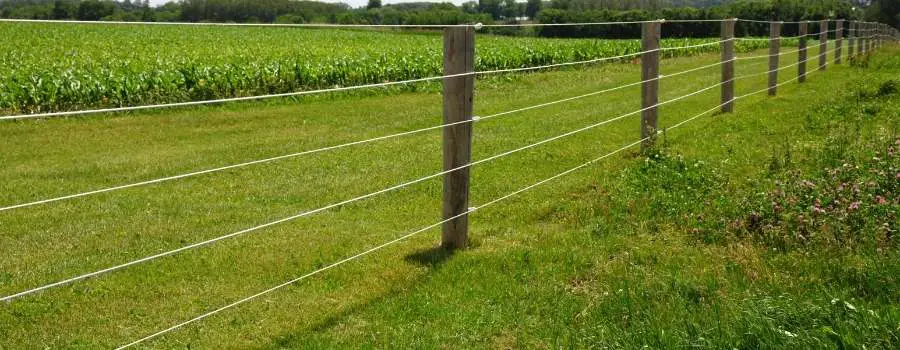
If you’re looking for a way to keep your animals in and predators out, you may be considering an electric fence. Electric fences are a great way to keep your animals contained, and they can be powered by solar energy!
In all honesty, if you have livestock you most likely already have an electric fence…but maybe you’re looking for a free way to power it. On the other hand, perhaps you’re looking to add some chicken or horses to a growing homestead and are just now starting to do some research.
I went on the hunt for as many questions about using solar power to energize electric fences as I could and put it all together in this guide.
Do Electric Fences Work With Solar Power?
In general, you can power an electric fence using solar power instead of connecting it to the electrical grid. All you’ll need to make that happen is to use a solar fence charger with a capacity that matches your needs.
Basically, the larger the fence, the more power you will need. To understand how much solar energy an electric fence charger needs to work effectively, we need to take a quick look at how it works and what its main components are:
- Solar Panel – The first thing that comes into your mind when thinking of solar fences is probably their photovoltaic panels. These are the devices that convert sunlight into electric energy and feed it to the fence charger’s battery or capacitor.
- Battery – Some solar powered fences use batteries in order to store energy for when there is no sunlight, such as at night. In this case, you will need a big enough battery that can store sufficient amounts of energy to power the fence all night long.
- Capacitor – Another component of electric fences is a capacitor that stores electric charge and discharges it when needed. The difference between batteries and capacitors lies in their storage capacity: while a battery can store much more power than a capacitor, the latter discharges it faster which makes them better for powering electric fences.
- Fence Charger – This device is the heart of any electric fence and its main function is to convert low voltage DC current coming from the solar panel into high voltage AC current that can be used on an electric fence.
As you can see, there are quite a few things that need to come together in order to get your solar fence fully functional. The most important one is to make sure that the solar panel and battery are capable of producing enough power for your needs.
What Is A Solar Fence Charger?
A solar fence charger is a device that uses solar energy to power an electric fence. It has a photovoltaic panel that converts sunlight into electric energy, which is then stored in a battery or capacitor. This energy is used to create a high voltage AC current, which can be used on an electric fence.
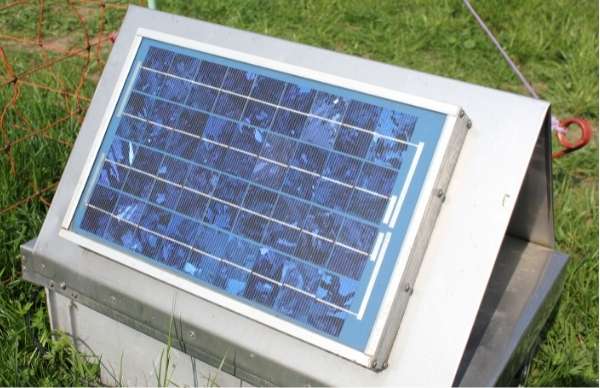
The solar fence charger has all the standard components you’d expect from a solar power system. Those parts include:
- Photovoltaic (PV) panel to absorb sunlight and generate electricity.
- Charge controller to regulate the system’s voltage.
- Battery to store excess electric power for use when there’s no direct sunlight available.
This kind of solar charger is incredibly convenient for setting up a self-reliant animal containment solution. For instance, farmers who wish to keep their livestock within a specific area will find a solar fence charger incredibly helpful.
On the other hand, the same setup could also help to keep people out of an area, like discouraging would-be intruders from climbing over your fence.
Using a solar fence charger is also an incredibly safe solution for the two applications above. That’s because any creature or person that touches a solar-charged fence will not get hurt or electrocuted. The fence just gives a mild shock that is enough to scare them away.
What Are The Pros And Cons Of Using A Solar Fence Charger?
Solar fence chargers come with their fair share of pros and cons. Here’s what you need to know about them.
Pros Of Using A Solar Fence Charger
- Off-Grid And Self-Reliant – A fencing system with a solar charger is entirely self-reliant. There’s no need to wire the system to the electrical grid or set up any power outlets.
- Flexibility – With a solar fence charger, your entire system is untethered. So, you have the flexibility of placing your fences anywhere you like, even far out into your fields. The same is true if you’re using the fence to prevent human trespassers from entering your property.
- Portability – A solar charger is entirely portable, which means your fencing system is, too. That’s an incredibly convenient feature for temporary fences that you can relocate to different parts of your property as needed. You can move it around or take it down anytime you want.
- Cost Savings – Of course, a solar fence charger reduces your costs. You won’t have to use grid power for your fences anymore.
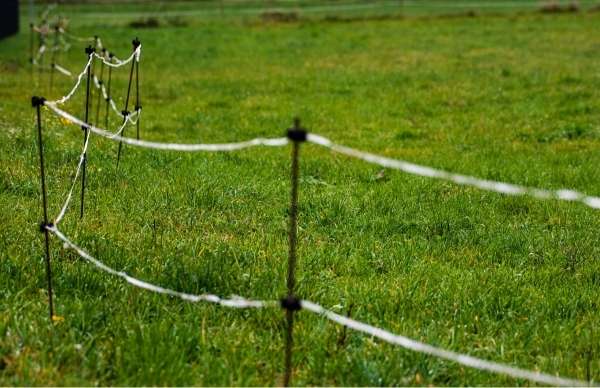
Cons Of Using A Solar Fence Charger
Like any other solar power system, a fence charger also has drawbacks. Still, you’ll find that the flaws pale in comparison to the benefits it offers. Here’s what to expect:
- Weather-Dependent – Solar power systems have one weakness: they can only generate power when they receive direct sunlight. The same is true with solar fence chargers as well. Don’t worry too much, though. As long as your system has a big-enough battery, your fence will stay electrified even on the cloudiest days.
- Maintenance – Solar fence chargers are not maintenance-free. Every now and then, you’ll have to wipe the solar panels clean. Dust and debris can build up on the solar panels, making them less efficient at harnessing sunlight.
- Not Suitable For Large Areas – Unlike a grid-powered electric fence, one with a solar charger has a somewhat limited capacity. So, it’s not ideal if you’re trying to fence off a vast area. But, of course, there is a workaround for that: you can power your fence with more than one solar fence charger.
Do Solar Fence Chargers Need Batteries?
In order to be effective at night, a solar fence charger will need a battery to store the electric charge. The battery will keep your fence electrified even when there’s no sunlight available.
The size of your battery bank depends on how large of an area you want to fence off and the amount of time you want the fence to stay powered up. Generally, you’ll need at least one battery for every 500 feet of fencing.
It’s important to note that not all solar fence chargers come with batteries. If you need to purchase a battery bank separately, make sure to get one that is compatible with your charger.
Remember, solar fence chargers work just like any other solar power system. Their solar panels must have direct sunlight to capture and convert into electricity. Once that’s done, the charger can then electrify the fence from one end to the other.
However, there are times of the day when no direct sunlight is available. For instance, at night or during cloudy days, solar panels can’t generate any electricity at all.
Unfortunately, a lack of power will make your fence pretty much useless. So the livestock you’re trying to contain can walk away without any problems, and trespassers can cross over into your property the same way.
That’s where the batteries come in. During a regular sunny day, your solar fence charger will deposit any excess power it generates into those batteries. Then, when the sun goes down, the batteries will discharge their energy and keep your fence electrified.
As a result, your fence continues to protect your property day and night.
Best of all, electric fences use a fraction of the power you’d use with any other appliance. So, a standard battery for your solar fence charger will last a couple of days at a minimum.
Even during seasons with no sunlight for days at a time, your fence will continue to work until the sun comes back out again.
How Much Distance Does One Solar Fence Charger Cover?
In general, one solar fence charger can cover a distance between 0.5 miles and 15 miles depending on the capacity of your fence charger and any anomalies, such as weeds, that may hinder its performance.
Here’s a crucial shopping tip to keep in mind. When comparing solar fence chargers based on their maximum distances or ranges, always consider the weed conditions around your property.
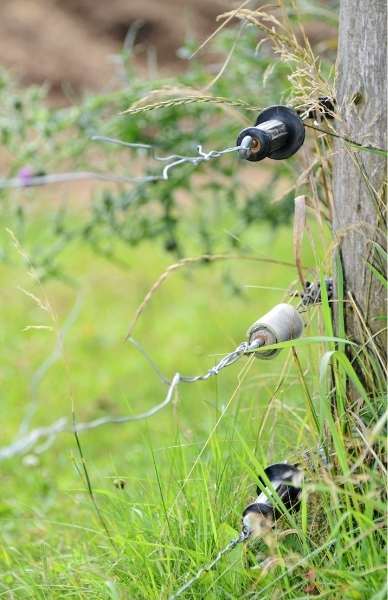
As weeds grow under and around your electrified fence, some will come into contact with the wiring.
That contact will increase the electrical resistance and reduce the charger’s overall voltage.
In simple terms, weeds will reduce the maximum distance that your solar fence charger can cover.
So, when it comes to weeds, you have two options to maximize the effective range of your solar fence charger:
- Reduce weeds – Firstly, you can choose to proactively remove weeds that grow along your electric fence. When you keep the fence clear of any weeds, your solar fence charger can continue electrifying your entire fence without problems.
- Get a more robust charger – in some situations, keeping your fences completely weed-free is not a practical option. In that case, you’ll want to invest in a solar fence charger that’s much stronger than what you think you’ll need. That way, the charger can continue electrifying your fence despite experiencing heavy weed conditions.
Is It Cheaper To Power An Electric Fence Using Solar?
In the short term, it is more expensive to power an electric fence using solar than it is using traditional power sources. However, when it comes to the total cost of ownership, a solar electric fence can be cheaper in the long run.
The price for solar has been dropping in recent years and is expected to continue doing so. Additionally, you may be able to take advantage of tax breaks or other incentives offered by your state or local government to switch over to solar.
There are a number of factors that will determine whether or not solar is the best option for your needs:
- The size of your property – If you have a large piece of land, installing a few solar panels to supply power to your fence may be the most cost-effective option.
- The length of your fence – If you have a short electric fence, solar panels may not be worth the investment. In that case, you’re better off sticking with traditional sources of electricity for powering your fences.
- The frequency at which you use your electric fences – If you only use your electric fences for a couple of weeks every year, solar will not be the most cost-effective option.
- The length of time that you expect to keep your property – The longer you plan on keeping your land, the more likely it is that installing a solar fence charger would make financial sense. Alternatively, if you only plan on using your electric fence for a short period of time, it may not be worth the investment.
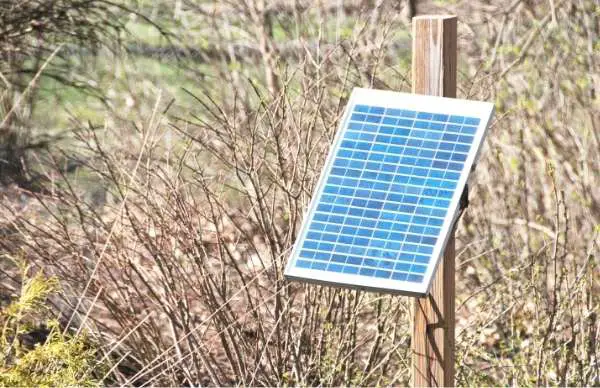
How Long Do Solar Fence Chargers Last?
In general, if your solar charger is getting at least five hours of direct sunlight per day, it should last around 20 years. The lifespan of a solar charger is largely dependent on the amount of sunlight it receives on an annual basis.
Keep in mind that the solar panel is only part of your solar charger. It also includes a battery that stores electricity for times when there’s no sunlight available to power your fence.
Batteries tend to have a much shorter lifespan than solar panels, so they are often the first component in a solar charger to break down or stop working. Most batteries will last for around five years before needing to be replaced.
To extend the life of your battery, you can keep it fully charged whenever possible by ensuring that your solar panel gets plenty of sunlight each day.
If you don’t use the solar charger very often, disconnect the battery from the charger when not in use. This will prevent it from wearing out as quickly and help you save money on replacement batteries.
You can also use a solar charger that has a replaceable battery, so when the battery wears out, you can simply switch it out with another one instead of having to purchase an entirely new unit.
How Do I Replace The Battery On My Solar Fence Charger?
Replacing the battery on your solar fence charger is a relatively easy process. All you need is a screwdriver and a few minutes of time.
- First, find the screws that hold the cover of the battery compartment in place. Remove these screws and set them aside.
- Next, lift up the cover and remove it from the battery compartment. Then, disconnect the old battery from the charger.
- Now it’s time to connect your new battery. Simply plug in one end of the power cord into the male port on your new battery and then plug in the other end into a female outlet on your charger.
- Once you have connected everything, replace the cover of the battery compartment and screw it in place. You’re now ready to start using your solar fence charger again.
Do Solar Fence Chargers Need To Be On To Charge?
Typically, solar fence chargers do not need to be on in order to charge. The battery will store energy from the sun during the daytime and use that energy to power your electric fence at night or on cloudy days.
It’s important to make sure that your solar panel is getting direct sunlight for at least five hours per day to ensure that your battery has enough energy stored up to power your fence all night long.
If you want the charger to be on during the daytime, but not at nighttime, set it to a timer so it will turn itself off automatically when you don’t need it anymore. You can find timers for solar chargers at most hardware stores or online.
Do Solar Fence Chargers Work In The Winter?
Solar fence chargers do work in the winter however since there is less sunlight during this time of year, your battery may not have as much energy stored up to power your electric fence after the sun goes down.

Of course, the further north you live the less sun you will get during the winter months.
If you live in a particularly cold climate, solar may not be the best option for powering your electric fence.
In cases like this, using a traditional source of electricity to power your fence may be more efficient and cost-effective in the long run.
Make sure you keep an eye on the battery level and replace it if needed so you can continue using your solar charger all winter long.
If you live in an area with a lot of snow, it’s important to keep the solar panel clear of any obstructions so it can get as much sunlight as possible.
You may also want to consider using a solar charger that has a detachable solar panel. This way, if there is too much snow on top of the panel, you can just remove it and place it somewhere else that gets more sun.
Can You Put Two Fence Chargers On One Fence?
Generally, you can put two fence chargers on one fence as long as they are not too close to each other. The closer the two chargers are to each other, the less effective they will be at charging your fence.
Ideally, you want to place your solar charger so that it’s facing in different directions so that one panel gets sunlight all day long while the other only receives light during certain times of the year.
If you are using a solar charger that has a detachable panel, you can place it in an area where it will get sunlight but not be too close to your actual fence line so there is no interference between them.
For example, if you have a large open field that gets plenty of sunlight, placing one charger at each end of the field will give you more coverage than just having a single charger in the middle.
This is also beneficial because it allows for better distribution of power across multiple sections of your fence line so there are no weak spots where animals can get through without getting shocked.
If you’re using a traditional source of electricity to power your fence, you can use the same method as mentioned above but instead of placing chargers on opposite ends, place them closer together and further away from each other so they are not too close to one another.
This will help ensure that even if one charger is not working correctly, the other will still be able to power your fence.
How Does A Solar Powered Fence Charger Work?
Solar-powered electric fence chargers work by using photovoltaic (PV) cells which convert light from sunlight into direct current (DC) electricity through a process called the photoelectric effect.
The DC power then goes to an inverter where it is converted into alternating current (AC) power which is used to power your electric fence.
Most solar-powered electric fences are battery-operated so they can work during the day and night or whenever there isn’t enough sunlight available.
The batteries are charged by the charging device while it’s in use, but they also take energy from the sun when there isn’t any other power source available.

Is A Solar Powered Electric Fence As Powerful As One That Uses Standard Electricity?
Solar-powered electric fences are not as powerful as those that use standard electricity, but they do have some benefits:
- They are also easier to set up and typically don’t require any additional tools or equipment like you would need to set up a traditional electric fence.
- They work well in areas where there is no access to standard electricity, such as rural areas or farms.
There are some types of solar-powered electric fences that can use both standard electricity and solar power in order to work. These are called hybrid fences and are often more powerful than those that just use one type of energy source, but they’re also more expensive.
There is a wide range of different types of electric fences on the market today so it can be difficult figuring out which ones are right for you and your property.
The best thing to do is think about what your needs are and whether or not they would be better served by either a traditional electric fence, a solar-powered one, or even a hybrid of both types.
You should also consider how much money you’re willing to spend on an electric fence since some can cost thousands of dollars while others are much cheaper.
It’s also good to know what types of animals you’re trying to keep out or away from your property since some fences work better than others against certain animals.
